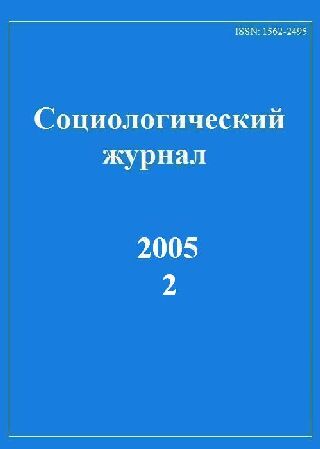Пост-гэллаповские опросные технологии: к 200-летию опросов общественного мнения в США
Аннотация
Литература
Докторов Б.З. К попытке определения пространства американских ме-тодических исследований опросных технологий // Социология: методо-логия, методы, математические модели. 2005. № 20. С. 10–31.
Докторов Б.З. О надежности измерения в социологическом исследова-нии. Л.: Наука, 1979.
Докторов Б.З. Обогащенное общественное мнение: понятие, социальная практика, опыт изучения // Мониторинг общественного мнения. 2004. № 3 (71). C. 58–70.
Докторов Б.З. Онлайновые опросы: обыденность наступившего столе-тия // Телескоп: наблюдения за повседневной жизнью петербуржцев. 2000. № 4. С. 16–31.
Докторов Б.З. Первопроходцы мира мнений: от Гэллапа до Грушина. М.: Институт Фонда «Общественное мнение», 2005.
Докторов Б.З. Повышение возврата анкет при почтовом опросе // Со-циологические исследования. 1981. № 3. С. 127–133.
Докторов Б.З. Типология методических исследований // Социологиче-ские исследования. 1989. № 1. C. 93–98.
Докторов Б.З. Эмиль Хурья. Забытая страница из истории изучения об-щественного мнения // Социологические исследования. 2005. № 2. С. 121–130.
Мягков А.Ю. Техника «рандомизированного ответа»: опыт полевого тес-тирования // Социологический журнал. 2002. № 4. С. 60–77.
Письмо Дж. Гэллапа Э. Томасу от 2 июля 1949 г.
Beville H.M., Jr. Audience ratings: Radio, television, and cable. Hillsdale, NJ: Lawrence Erlbaum Associates, 1985. P. 17.
Couper M.P. Web surveys: A review of issues and approaches // Public Opinion Quarterly. 2000. Vol. 64. No. 4. P. 464-494.
Daniels D. Giants, pigmies, and other advertising people. Chicago: Crain Communications, Inc., 1974. P. 44.
Fisher A. Do Nielsen's broadcast ratings have a future in the coming interac-tive age? [online]
Fishkin J.S. Democracy and deliberation: New directions for Democratic re-form. New Haven: Yale University Press, 1991.
Fishkin J.S. The voice of the people: Public opinion and democracy. New Haven: Yale University Press, 1995.
Gallup G. A reply to “The pollsters” // Public Opinion Quarterly. 1949. Vol. 13. No. 1. P. 179.
Gallup G. Accuracy of modern polling techniques in making election fore-casts. The Carl Albert Congressional Research and Studies Center Search. Helen Gahagan Douglas Collection. Box 157: Political Papers. University of Oklahoma. 1948.
Gallup G. Test of polling accuracy met in Canadian election. 1949. June 30. The Carl Albert Congressional Research and Studies Center Congressional Archives. University of Oklahoma. The Elmer Tomas Archive.
Gallup G. The changing climate for public opinion research // Public Opinion Quarterly. 1957–1958. Vol. 21. P. 23-27.
Gallup G. The polls and public opinion / Ed. by N.C. Meier, H.W. Saunders. New York: Henry Holt & Company, 1949. P. 177.
Herbst S. Numbered voices: How opinion polling has shaped American politics. Chicago: University of Chicago Press, 1995. P. 76.
Knowledge networks collaborates with Stanford University, University of Texas (Austin) to bring innovative survey technique to representative Internet panel [online].
Link H.C. Employment psychology: The application of scientific methods to the selection, training and grading of employees. New York: The Macmillan Company, 1919.
Link H.C. Some milestones in public opinion research // Journal of Applied Psychology. 1947. Vol. 31. No. 3. P. 226-227.
Link H.C. The new psychology of selling and advertising. New York: The Macmillan Company, 1932.
Merkle D.V. Review: The national issues convention deliberative poll // Public Opinion Quarterly. 1996. Vol. 60. No. 4. P. 588-619.
Opinion Polls. Interviews by Donald McDonald with Elmo Roper and George Gallup. Santa Barbara, CA: Center for the Study of Democratic Institutions, 1962. P. 1.
Pitkow J.E., Recker M.M. Results from the first WWW user survey [online].
Proceedings of the fifty-first annual conference of the American Association for Public Opinion Research // Public Opinion Quarterly. Vol. 60. No. 3. P. 471-513.
Robinson C.E. Straw votes: A study of political prediction. New York: Co-lumbia University Press, 1932.
Rogers L. The pollsters: Public opinion, politics, and democratic leadership. New York: Alfred F. Knopf, 1949.
Starch D. Measuring advertising readership and results. New York: McGraw-Hill, 1966. P. 10-11.
Sturgis P., Roberts C., Allum N. A different take on the deliberative poll: Information, deliberation, and attitude constraint // Public Opinion Quarterly. 2005. Vol. 69. No. 1. P. 30-65.
The black and white beans // Time. 1948. May 3. P. 22 [online].
The Gallup poll. Public opinion 1935–1941. Vol. 1: 1935–1948 / Ed. by G. Gallup. New York: Random House, 1972. P. viii.
Warner S.L. Random response: A survey technique for eliminating evasive answer bias // Journal of the American Statistical Association. 1965. Vol. 60. No. 309. P. 63-69.
Yepsen D. Straw polls have played role in political history // Des Moines Reg-ister. 1999. August 9 [online].
Все права на статью принадлежат авторам. Авторы передают права на использование статьи, в том числе на использование статьи в открытом доступе, издателю журнала на условиях неисключительной лицензии (Авторское соглашение (публичная оферта))
Принятием условий этого договора автором считается передача им материалов в редакцию через официальный сайт журнала ("Отправить рукопись") или через электронную почту редакции.











